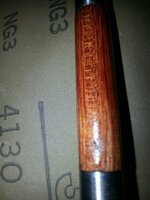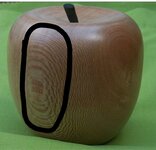You are using an out of date browser. It may not display this or other websites correctly.
You should upgrade or use an alternative browser.
You should upgrade or use an alternative browser.
pic of blank
- Thread starter franka
- Start date
Signed-In Members Don't See This Ad
Signed-In Members Don't See This Ad
1080Wayne
Member
That is the natural edge grain of the wood that you are seeing . Some woods show it more than others . That piece has been cut straight with the grain . An angle cut will give a different appearance .
SteveJ
Member
Unless you are talking about the black marks towards the bottom...
Those could be metal filings from sanding the bushings and then bringing the sandpaper back onto the blank.
Those could be metal filings from sanding the bushings and then bringing the sandpaper back onto the blank.
Its hard to tell from your picture what the problem is. Are there radial lines around the blank at the bottom of the picture? Has the end chipped or torn off a little bit? Do you mean the lighter colored swirls/pattern from the wood grain that are a natural part of the wood? cherry does that a lot.
Which wood are you using?
mjrbuzz
Member
it looks like the natural edge grain to me, i get it alot in mahogany, mesquite and walnut. honestly its some of my favorite parts  maybe run the clip down one side of it?
maybe run the clip down one side of it?
Yes the swirls just looks bad to me and is on almost every blank i turn.
I would say get used to it and learn to like it. It is a feature of the wood. I would not recommend that you cut the wood any differently. Personally, I like to see this happening on the wood blanks I turn. There is nothing wrong.
RedBeard
Member
Looks like edge grain to me as well and as far as I can think of there is no way to avoid that completely other than maybe gluing some thin veneer to a tube and then cast in something like Alumilite....which just seems counter productive to turning a wooden pen.
Last edited:
low_48
Member
These are usually called medullary rays. They are radial lines in many species. Very predominant in oak, minor in species like this. You'll have to change species if you don't like them.
CREID
Member
A real good solution to this problem is to turn acrylics.
Curt
Curt
1080Wayne
Member
Woods in which you wont see them so prominently include most poplars and cottonwoods , hophornbeam , California laurel , elms ,ashes , sassafras , osage orange , catalpa , black locust , Kentucky coffeetree , sumac , persimmon , black walnut , butternut , magnolia , basswood , birches , willows , yellow buckeye , sweetgum , black tupelo . However , you may see other things you don`t like in some of them .
Never worked with wood until now. I built things from metal and it is a little more forgiving. I was forced to retire and had to have something to kep me buisy. All of my friends now drop wood off so i have a lot to choose from. So when it showed up in five ir six different wood and me being a wood virgin i thought i had a problem. things have allways had to look good to me or i started over. Hell i built a trike four times befor i got it right in my mind. My friends thought i was crazy they thought it was perfect the first time. maybe they were right i may be crazy. So thanks for seting me stright i will try to do better.
KenV
Member
The picture is not very detailed -- I think I see a flaw in the finish near the bottom of the photo -- I think I also see radial sanding lines.
The challenge is that there is glare at the lower end where you have the problems and the glare is obstructing much of the detail.
I have to guess -- the radial lines suggest that you are not sanding adequately in a linear along the pen. Your sanding sequence is not removing the sanding marks from the previous abrasive before you are moving ahead -- Light across the pen at an oblique angle will show the scratches.
You have not stated the wood -- and if it has hard spots and softer ones, that can make the turning of a smooth surface more difficult - especially if you are not paying close attention and carefull and lightly riding the bevel. What do your finger tell you of the surface??
Slow down in your shear cuts, be careful in your sanding assuring that you remove the scratches from previous abrasives - got to P600 or P800 before applying the seal coat and use fresh abrasives.
The challenge is that there is glare at the lower end where you have the problems and the glare is obstructing much of the detail.
I have to guess -- the radial lines suggest that you are not sanding adequately in a linear along the pen. Your sanding sequence is not removing the sanding marks from the previous abrasive before you are moving ahead -- Light across the pen at an oblique angle will show the scratches.
You have not stated the wood -- and if it has hard spots and softer ones, that can make the turning of a smooth surface more difficult - especially if you are not paying close attention and carefull and lightly riding the bevel. What do your finger tell you of the surface??
Slow down in your shear cuts, be careful in your sanding assuring that you remove the scratches from previous abrasives - got to P600 or P800 before applying the seal coat and use fresh abrasives.
NittanyLion
Member
Sabaharr
Member
If you decide you don't like that at all I suggest you stay away from leopard wood and snake wood.
TurtleTom
Member
Surely he's talking about the black marks from the mandrel. Who would complain about wood grain like that?


